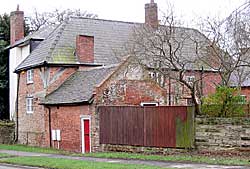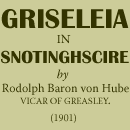< Previous | Contents | Next >
Watnall
 This timber-framed cottage at Watnall dates from the mid-15th century (Photo: A Nicholson,
2004).
This timber-framed cottage at Watnall dates from the mid-15th century (Photo: A Nicholson,
2004).WATNALL also Watenhow, Watnowe, and Watnow, is in the Domesday Survey written Watenot. Flavel Edmund derives the “Wat” from “Watel,” a wattled fortification or defence, formed with the trunks of trees interlaced with boughs and plastered over; and Mr. Potter Briscoe gives “all” as coming from “sal,” a seat. It seems to us very possible that that may have been so. Watnall then would have been the Key of the Greasley defences, and together with the “Berew” of Kimberley and the Crow Hill position would have commanded the heights, not only as posts of observation, but from whence at the shortest notice to send help into any other direction of the Parish, without which Greaseley would have been helplessly unprotected, except by the sheltering positions of High Park Wood and Fulwood, in which to keep from the observation of an enemy the post of reserves, such as in those early days they may have been.
Watnall after the Conquest was Peverel’s fee. In the Confessor’s time Grunchel (whom we have met at Kimberley, and shall meet again in Newthorpe) had a manor here, which paid to the Danegeld for one carucate. Another manor was Siewards, which paid for 2 bovats, and had soc in Watnall. Of this soc one “Grim” had one bovat for the geld, with soc in Bulwell and Ailmer had also of this soc, which paid for 2 bovats to the geld, the land being one carucate. There was also in demesne 1 carucate, 1 socman, 2 villes and 2 bordars having 1 carucate, and 5 quarantines’ length of pasturewood by 4 quarantines width. This demesne, when the survey was taken, was held by Grunchel and Gozelinus, the latter of which two, as seen in the history of Lenton, was one of Peverel’s men, and this is all which Grunchel was permitted to retain from all his properties in the parish of Greasley, which were his in the Confessor’s time. We have no further information of early date about this hamlet until the time of King John, in the 12th year of whose reign Robert, son of William de Alfreton, was certified to hold of the Escheat of Peverel (among other properties elsewhere) half a Knight’s fee at Watnall. This half Knight’s fee descended to the Chaworths, whose name is derived from Cadwecis, as shewn in page 5 of Patronymica Britannica, while another part of the hamlet went from the Lords of Greasley (descendants of another one of Peverel’s men) to the de Canteloupes, and hence the distinction, which to this day remains, of Watnall Chaworth and Watnall Canteloupe. Thoroton in the next place infers from the Test. de Nevil, that Hugh de Redinges (who we judge was of a junior branch of the family of de Alfreton) was also called Hugh de Watenhow or Watnow, and had an estate in this township, which was held from him by one Tolly, and afterwards by Galfrey Stoyle. Of this estate, Hugh de Watenow (as we shall now call him) gave 1 bovat of land to Lenton Priory, with the reservation, however, that during his lifetime he would hold it himself, paying the monastery 16 pence yearly, but that after his death the Priory might dispose of it as their own land, and he granted common to their tenant, as the rest of the men of Watnall had in all places. In return for this grant the monks of Lenton were pledged to make an anniversary for his father, and he left a bitter curse for his heirs, if any of them should attempt to go against or hinder this gift. The monks demised that land to Robert, son of Roger de Watenhow, for his life, and after him in the time of Henry III. to Sir Robert Lathom for his life, for a noble yearly, which same amount of rent was still later on paid in the 5th year of Edward I. by Robert, son of Robert de Watenhow. This last-named Robert was probably thus provided for while in expectation of better things to come, for one Hugo de Watenhow had left half a Knight’s fee in Watnall, in the early part of Henry III’s reign, which eventually came to Robert de Watenhow; but in the 9th year of Edward II. it had come to Robert de Kimmerley, whom we have mentioned in the township of that name), and who was then certified to be Lord of it.
We must next turn to the Borough Records, where in the same above mentioned 9th year of Edward II. i.e., on August 24th, 1316, a grant is registered from a certain George Wase of Watnall to William de Amyas, a Burgess of Nottingham, of a tenement in Watnove, to which the following were witnesses: Stephen de Watnowe, John de Colson, Thomas de Cressy, Ranulf de Colston, and John Attegreene. Dated at Watnove.
We find next from Thoroton, that in the third year of Edward III. Stephen de Kimmerley was a descendant from Robert de Kimmerley, and that a fine was then levied at Nottingham on the Monday next before the feast of St. Martin, between William de Mekesburgh of Nottingham and John de Hacunthorpe and Agnes his wife, who acknowledged the manor of Watnall Chaworth as the inheritance of the said Agnes, and that 2 parts of that manor, which were then held in dower by Joan, who had been the wife of Stephen de Kimmerey, were of the right of the said William (de Makesburgh).
We turn from thence again to the Borough Records, and under date of the i6th June, 1348, the following is registered, i.e
A grant from Bartholomew de Cotgrave to William de Amyas of Nottingham and Margery his wife, of the manor of Watnall Chaworth with all appurtenances, a windmill and bondmen, &c., &c., and also of his manor of Reddinges, near Alfreton, with appurtenances, a watermill and bondmen, &c., &c., to be held for their lives.
With remainder to Hugh de Spicere of Nottingham and Joan his wife, daughter of the said William de Amyas.
With remainder to their son William and his heirs, male.
With remainder, in default of heirs, to Agnes, daughter of the said William de Amyas.
And remainder, after the death of the said Agnes, to William, son of Robert de Wolaton of Nottingham, and his heirs, male
With remainder, in default of heirs, to John, son of Ralph de Wollaton of Nottingham, and his heirs, male.
With remainder, in default of heirs, to Thomas, son of Ralph de Wollaton of Nottingham, and his heirs, male.
With remainder over to the right heirs of the said William de Amyas.
The witnesses to which grant were: John de Annesley, Knight, William de Seiston, Robert de Sutton, William de Worthington, Stephen Smyth of Watnall, and John de Stanleye, Cordwaner.
